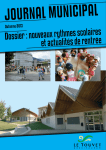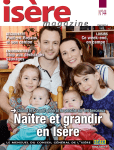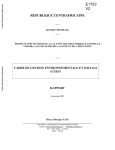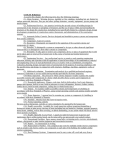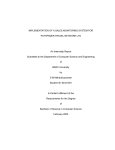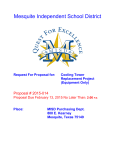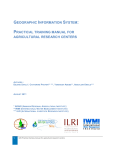Download U.S. USER GUIDE
Transcript
U.S. USER GUIDE BUILDING SUPPORT FOR GLOBAL DEVELOPMENT TABLE OF CONTENTS Introduction....................................................................................................................................................................................... 1 Using This Guide .................................................................................................................................................................. 3 Methodology............................................................................................................................................................................... 4 Audience Overview ................................................................................................................................................................. 5 The Narrative ............................................................................................................................................................................ 10 Narrative Approach ....................................................................................................................................................... 11 Narrative Messages...................................................................................................................................................... 12 Narrative Tagline............................................................................................................................................................... 13 Narrative, Long-form..................................................................................................................................................... 14 Language Tips...................................................................................................................................................................... 15 Key Research Insights (Do’s and Don’ts)................................................................................................. 19 Applied Narrative Examples .................................................................................................................................... 22 Attacks & Responses ....................................................................................................................................................... 29 Creative Tools ............................................................................................................................................................................ 32 Images........................................................................................................................................................................................... 33 Creative Brief......................................................................................................................................................................... 39 Content Creator’s Checklist................................................................................................................................. 42 INTRODUCTION 1 GOAL: CHANGE THE CONVERSATION CAN YOU CHANGE A NARRATIVE? Earlier this year, a group of organizations (see sidebar) who work together on global equity issues asked a question: can the public conversation about global development be changed to foster a more positive understanding of the issues? Partners That is a question that has been asked for years and has prompted many studies and research efforts in search of an answer. During that time, the debate around global development has become negative and broken. The public conversation focuses on what doesn’t work and what is wasted. The base of active supporters for global issues is shrinking and often ill-equipped to talk about any of the positive change happening around the world as a result of development programs. THE NARRATIVE PROJECT To find a new approach, these organizations created The Narrative Project: a research and communications effort focused on changing the development narrative in the United States, United Kingdom, France and Germany. The project consulted with experts across the fields of linguistics, anthropology, psychology, marketing, political science, development, political economics, public opinion and communications. It used qualitative and quantitative research and message testing to develop a set of insights about how to change the narrative and create a broader base of public support for global issues. NEW FINDINGS While the project confirmed many insights from previous studies, it also uncovered some exciting new findings, including language usage and messages that can help the global development sector create momentum around its work. Perhaps most important, The Narrative Project identified an undecided audience that, when reached the right way, could significantly increase the base of support for development. The User Guide is a tool to bring these findings to life. 2 USING THIS GUIDE The User Guide is designed to be an informative tool for communicators and advocates who want to apply The Narrative Project approach to their own messages and content. It brings together the highlights of The Narrative Project research and lays out a narrative approach, which is based on a deep analysis of those insights. Here are some practical suggestions for how to use the guide: • The first section, Audience Overview, describes the specific target audience and strategy that the research and User Guide were designed around. Read this section carefully. A clear understanding of it is essential to using the guide. • The remaining sections describe the research-based narrative approach along with messages and language that bring that approach to life. They also provide examples of how the narrative approach can be applied in practice. Read through the full guide, then go back to find the pages that help you the most. • The Narrative Project User Guide Summary is meant to be used as a quick reference tool once users understand the findings. • The next step is to try out the narrative approach in the real world. It can be used to create anything from speeches to video content to social media. To determine if The Narrative Project approach can truly help change the conversation, organizations need to test it for themselves, see what works, refine, and test again. The insights and recommendations presented in this guide represent one path for changing public perceptions about global development. They are not a one-size-fits-all solution. Each user will have to apply the concepts, messages, and language to their own work with care and creativity. 3 METHODOLOGY CONDUCTING RESEARCH WITH THE ENGAGED PUBLIC From February to August 2014, the 15 organizations in The Narrative Project’s Working Group guided in-depth research to inform the creation of a new narrative. The process began with an exhaustive review of existing research on public attitudes, in order to build upon prior knowledge and the work of others within the sector. The Working Group also conducted an audit of the frames development organizations use in their communications, which define the public dialogue today. Along with leaders in the development field, a team of social scientists, linguistics, political advisors and public-opinion researchers contributed expertise and ideas. Focus groups were used to develop and test ideas for a new narrative with people in the United States, United Kingdom, France and Germany. Online surveys with 1,200 members of the public in each of those countries measured the persuasive power of various themes, based on their ability to change attitudes and motivate people to take action to support development. The most powerful themes formed the approach for the new narrative, which was then crafted with a structure and language determined to deliver maximum motivating power to both supporters and potential supporters of development. Research & Development Process 1) Review existing research 2) Conduct sector narrative audit 3) Develop new narrative ideas in focus groups 4) Test narrative ideas in surveys 5) Craft language 6) Test language for motivating power 7) Use language in public communications & test audience responses 4 AUDIENCE OVERVIEW Research conducted for The Narrative Project divided members of the Engaged Public into three groups based on their attitudes toward global development: Supporters, Swings and Skeptics. This section describes attitudes and demographics for each segment in the United States. 5 AUDIENCE TARGET: THE ENGAGED PUBLIC “Stories about extreme poverty in other countries make me sad because I don’t like the idea of innocents starving and dying. However, I feel like there is little I can do personally, and I know we have starvation and homelessness in our own country.” – U.S. survey participant The Narrative Project Working Group commissioned a body of research to better understand public attitudes toward development. For this project, the “public” is defined as the Engaged Public in the United States, United Kingdom, France and Germany. The Engaged Public is an important slice of the general population in these countries: people who follow global issues, talk about them with others and feel that it’s important to “improve health, education and economic opportunity for the world’s poorest people.” Focusing on the Engaged Public is critical because they are the group that is most likely to listen to information disseminated by the development sector and they are also more likely to donate money to development charities and volunteer their time to campaigns. The rest of the public tends to be far more disengaged and far more likely to have negative attitudes about development. Persuading more of the Engaged Public to support development work before turning to a broader public audience is the path to reaching more people. If we can’t convince the Engaged Public, we won’t be able to convince anyone else. The Narrative Project examined the attitudes of three groups within the Engaged Public: Supporters, Swings and Skeptics. The Narrative Project research showed that we can expand our base of support with a narrative that will persuade Swings to think and feel more positively about development. The same messages can also empower Supporters and appease Skeptics. The Challenge The Engaged Public in the United States represents less than a third of the population. 26% Engaged Public 74% Disengaged Public % of Engaged Public in U.S. population The Opportunity Within the Engaged Public, we can potentially double the number of people who support development if we can persuade Swings to think and feel more positively about development. 49% 39% % of Swings within the U.S. Engaged Public % of Supporters within the U.S. Engaged Public 6 AUDIENCE STRATEGY: EMBOLDEN THE BASE The narrative that will encourage the Swings to embrace development can also bolster Supporters and motivate them to continue to work hard to support development. Here are some key facts about Supporters. Ideology Engaged Public 29% Supporters 34% SUPPORTERS Liberal 41% 25% 43% Moderate 18% Conservative Age Supporters have a positive attitude toward development and form a powerful base of support. They volunteer, donate, raise their voices, and take other action and they believe they can make a difference. We can get them to do more, but they’re already on our side. They represent nearly half of the engaged public. Engaged Public 26% Supporters 33% 18-34 16% 18% 18% 35-44 45-54 39% 19% 30% 55-69 Education Supporters are 47% of the Engaged Public in the United States Engaged Public 15% 39% 29% 16% Supporters 15% 39% 29% 16% High School Graduate Some College/A. A./Prof. Degree Bachelor’s Degree Master’s/Doctorate Degree Gender 41% Engaged Public “As a developed nation we have a moral responsibility to bring any people across the world to a decent level of education and health, and it is a shame and a disgrace that all people do not have these opportunities.” — U.S. SURVEY PARTICIPANT 37% Supporters Male 59% 63% Female 7 AUDIENCE STRATEGY: SWING THE SWINGS Narrative Project research showed that we can expand our base of support with a narrative that will “swing the Swings” to embrace development. Here are some key facts about Swings. SWINGS Ideology Engaged Public 29% 41% 25% Swings 27% 40% 29% Liberal Swings have a neutral to positive attitude toward development. They believe we have a strong obligation to help people in the world’s poorest places, but they also can be led to believe that development programs are wasteful. Their opinion can “swing” from positive to negative. Swings represent our biggest opportunity and could potentially double our base of support. If we can convince them that they can make a difference, that belief will help drive them to take action. Moderate Conservative Age Engaged Public Swings 26% 16% 23% 14% 18-34 35-44 18% 39% 18% 45-54 45% 55-69 Education Swings are 39% of the Engaged Public in the United States “My heart goes out to the people suffering such extreme poverty. I don’t know how I can change it.” — U.S. SURVEY PARTICIPANT Engaged Public 15% Swings 15% 39% 42% 29% 27% 16% 16% High School Graduate Some College/A. A./Prof. Degree Bachelor’s Degree Master’s/Doctorate Degree Gender Engaged Public 41% 59% Swings 43% 57% Male Female 8 AUDIENCE STRATEGY: APPEASE THE SKEPTICS Skeptics are helping to drive the negative narrative about global development. The same narrative that can swing the Swings and embolden Supporters can also placate Skeptics so that they don’t dominate public dialogue on global development. Ideology Engaged Public Skeptics SKEPTICS 29% 41% 18% 25% 38% Liberal Moderate 37% Conservative Age Skeptics are helping to drive the negative narrative about development. They feel strongly that development is not effective and their attitudes are unlikely to change. Skeptics can pull Swings away from a positive perception of development toward a negative one. Engaged Public Skeptics 26% 15% 16% 14% 18-34 18% 18% 35-44 39% 52% 45-54 55-69 Education Skeptics are 14% of the Engaged Public in the United States Engaged Public 15% 39% Skeptics 13% 39% — U.S. SURVEY PARTICIPANT 30% 16% 16% High School Graduate Some College/A. A./Prof. Degree Bachelor’s Degree Master’s/Doctorate Degree Gender Engaged Public “I am not convinced money goes to these programs but is absorbed by corrupt governments. It is a total waste of time and money.” 29% Skeptics Male 41% 59% 47% 53% Female 9 THE NARRATIVE This section provides guidance on the themes and language that are most effective in building support for development among the Engaged Public. 10 NARRATIVE APPROACH The most important lesson from The Narrative Project research is simple: The theme of “independence” as the end goal of development is the most critical idea to communicate to the public. This finding challenges the development sector’s current communications practices. It also has the power to transform our work and its impact. Using the full narrative approach shown in the diagram below - “independence” first, followed by “shared values” and “partnership” - will pack the most persuasive power for Swings. It also emboldens Supporters and appeases Skeptics. However, if you only have time or space to communicate one theme to any audience, “independence” is the most influential. The theme of “progress” is not part of the core narrative approach but was found to be a valuable supporting idea. INDEPENDENCE SHARED VALUES Research Insights INDEPENDENCE Emphasizing independence as the end goal of development is the most compelling theme across all audiences—and helps convert the most Swings to Supporters. SHARED VALUES This theme reminds most people of a belief that they already hold: every human life has value, and we have a moral obligation to help people who live in the world’s poorest places. PARTNERSHIP PARTNERSHIP Explaining that people in developing countries actively participate in making development programs work is a critical theme for Swings. CORE THEMES PROGRESS The theme that development programs are effective supports the other ideas in the narrative by educating the public on what has been achieved—but was shown not to be persuasive on its own or as a lead theme. SUPPORT THEME PROGRESS 11 NARRATIVE MESSAGES INDEPENDENCE: Development programs help people in the world’s poorest places become independent and stand on their own two feet. Language testing with members of the Engaged Public showed that these were effective words and phrases to express the narrative themes to our target audience. SHARED VALUES: People born in the world’s poorest places deserve the chance to achieve their full potential, because every human life is valuable. PARTNERSHIP: Development programs work because people from across countries and communities join forces to share knowledge, resources and responsibility. PROGRESS: Development programs work. We’ve beaten smallpox, nearly defeated polio and helped millions of people get education and training. 12 NARRATIVE TAGLINE The tagline is a simple phrase that sums up the purpose of development. It employs the metaphor of “building foundations” to underscore the long-term impact of development programs. It highlights the most important theme to communicate to our target audience: development helps people achieve independence. Building the foundations of independence. In language testing, “independence” was the most popular term for the theme of self-sufficiency to U.S. audiences. “Self-reliance” and “self-sufficiency” also work well. 13 NARRATIVE, LONG-FORM This is an example of a full articulation of the narrative approach. The purpose of development is to help people become independent. Development programs offer people in the world’s poorest places a hand up, so they can build the foundations of independence: education, health and economic opportunity. This work is essential because every person deserves the opportunity to live with dignity and reach their full potential—regardless of where they are born. Development programs are a two-way street. People from different countries join forces to share knowledge, resources and responsibility. Development is working. The number of children who die before age five has shrunk by almost half. Preventable diseases are disappearing. Millions of people use training and education they didn’t have before to improve their lives. Let’s keep making the world a better place. We’ve come too far to stop now and undo all the progress we’ve made. Tips for Articulating the Narrative þþ Showing how development programs help people become independent—using specific examples such as “education, health and economic opportunity”—helps our audience understand and support the work. þþ Describing people in terms of their hopes and values—as in the phrase “to live in dignity and reach their full potential”—creates empathy with the people served by development programs and encourages our audience to support development. þþ Metaphors—such as “two-way street”—help our audience understand the idea of partnership and picture people working together in meaningful ways. þþ Presenting problems as solvable—as in “preventable diseases”—communicates that progress is possible, which motivates people to support the effort. People are more likely to take action in support of development when they hear specific, tangible examples of progress like these. þþ People can be motivated to take action to avoid losing something valuable—as expressed here in the phrase “undo all the progress we’ve made.” 14 LANGUAGE TIPS: GENERAL LANGUAGE NARRATIVE THEME EXPLANATION development “Development” can be a vague word for people who aren’t experts in the field, but in general the term carries positive meanings. “Foreign aid” has strongly negative connotations for our audience. independent In research with U.S. audiences, this was the favored word to describe the goal of development. “Self-sufficient” and “self-reliant” also work. people in the world’s poorest places This avoids stigmatizing people by associating “poor” with their circumstances, rather than the people themselves. build the foundations Building “foundations” is a metaphor that implies long-lasting impact on people’s lives. education, health and economic opportunity These terms refer to specific types of development programs that most people understand and value. You can provide other examples, too. every person, regardless of where they are born This language tested well with Supporters, Swings and Skeptics. These phrases address the idea of equity in familiar terms that our audience can relate to. opportunity, dignity, full potential These words express values and beliefs shared by our audience and by people who benefit from development programs. two-way street, people from different countries, join forces, share These words and phrases make the idea of partnership come alive. knowledge, resources and responsibility These examples make it clear that people who benefit from development programs contribute something valuable to the work. working, shrunk, disappearing, improve These action verbs and concise statements convey confidence in the idea that progress is being made. 15 LANGUAGE TIPS: SUPPORTERS THEME KEY IDEAS Independence INDEPENDENCE Equity SHARED VALUES Human Traits Sharing PARTNERSHIP Accountability LANGUAGE Succeed by their own merit Sustainable change Lasting difference Determine their own future Control their own destinies People lack opportunity Equal chance People cannot help where they are born Pride Energy Determination Tenacity Hope Persistence Striving to help themselves Working with poor countries Sharing knowledge and expertise Hand up not a handout Transparent Accountable Proven long-term efforts Can’t blindly support Rigorous evaluation EMPHASIS Neutral Supporters are particularly motivated by some ideas and turned off by others. When addressing Supporters, emphasize language about shared values and the traits of people striving for a better life and de-emphasize language about accountability. Dial Up Dial Up Neutral Dial Down 16 LANGUAGE TIPS: SWINGS THEME KEY IDEAS Independence INDEPENDENCE Equity SHARED VALUES Human Traits Sharing PARTNERSHIP Accountability LANGUAGE Succeed by their own merit Sustainable change Lasting difference Determine their own future Control their own destinies People lack opportunity Equal chance People cannot help where they are born Pride Energy Determination Tenacity Hope Persistence Striving to help themselves Working with poor countries Sharing knowledge and expertise Hand up not a handout Transparent Accountable Proven long-term efforts Can’t blindly support Rigorous evaluation EMPHASIS Dial Up Swings found all of the narrative themes to be relevant, but responded particularly well to language about independence, traits of people striving for a better life and accountability. Neutral Dial Up Neutral Dial Up 17 LANGUAGE TIPS: SKEPTICS THEME KEY IDEAS Independence INDEPENDENCE Equity SHARED VALUES Human Traits Sharing PARTNERSHIP Accountability LANGUAGE Succeed by their own merit Sustainable change Lasting difference Determine their own future Control their own destinies People lack opportunity Equal chance People cannot help where they are born Pride Energy Determination Tenacity Hope Persistence Striving to help themselves Working with poor countries Sharing knowledge and expertise Hand up not a handout Transparent Accountable Proven long-term efforts Can’t blindly support Rigorous evaluation EMPHASIS Independence and accountability are essential themes to emphasize with Skeptics. They do not respond well to language about shared values. Dial Up Dial Down Neutral Neutral Dial Up 18 KEY RESEARCH INSIGHTS This section presents the most critical narrative research insights in a simple list of Do’s and Don’ts. 19 RESEARCH INSIGHTS: DOs Do lead with “building independence” as the purpose of development programs. This idea persuades Swings and motivates Supporters. Do talk about empowering women and girls in the developing world. Gender equality is a powerful argument in support of development for the Engaged Public. Do provide examples of progress in the context of other ideas in the narrative. Simply asserting that development programs work is ineffective unless you pair examples of progress with messages about independence, shared values or partnership. Do use simple, clear and bold language to assert the accomplishments of development programs. But be cautious of overreaching or making claims you can’t back up. Do emphasize core human values and priorities that are relatable to both donor and developing country audiences. Do highlight partnership in all aspects of development programs. Describing the active contributions of development program recipients contrasts with the traditional image of passive charity recipients. Do use familiar language that our audience will understand immediately. Speaking in development jargon makes it more difficult to build understanding and support. 20 RESEARCH INSIGHTS: DON’Ts Don’t expect facts and figures about progress alone to convince people to support development. Many people won’t listen to the facts until they understand why they should support development (independence, shared values) and how it works (partnership). Don’t invoke pity or characterize people in developing countries as helpless victims or assert that people have an obligation to support development. People react negatively to the perception that their sense of morality is being questioned. Don’t lead with negative concepts or words. Messages that start by describing “the problems” that development programs are working against are less convincing than talking about “why” a person should support development (for example: independence, shared values, the value of human life). Don’t use long-term timeframes to communicate a goal or vision. Referencing dates that are far into the future (such as 2030) don’t engage people or encourage them to support development. Don’t use the term “foreign aid.” For many people, including the Swings, it carries a lot of baggage. Many associate the term with short-term crisis, and others associate it with money that is wasted. Don’t describe the goal of development as furthering the economic or national security interests of donor countries. Most people don’t find these “self-interest” arguments persuasive. Don’t try to downplay the problem of corruption. Most people believe that corruption is common within development work and you won’t be able to convince them otherwise. Don’t try to explain away or justify problems with some development programs. Language such as “in the past, development wasn’t very effective” or “there will always be some setbacks” is not effective. 21 APPLIED NARRATIVE EXAMPLES This section shows how ideas and language in the narrative can be applied in different forms of communication. 22 EXAMPLE: CAMPAIGN MESSAGING EXAMPLE PROVIDED BY THE UNITED NATIONS FOUNDATION ORIGINAL MESSAGE We have met mothers who will walk for miles for the opportunity to vaccinate their children. We want to give them the opportunity to provide their children with a healthy shot at life. The fact is 1 in 5 children are dying before the age of 5 from preventable diseases and we have the power to help. Shot@Life supports the work of the UN, GAVI and other global partners to deliver life-saving vaccines to children in developing countries, many in hard to reach, rural areas. This work would not be possible without the support of the American people and U.S. government. NARRATIVE THEME Independence g Independence g Partnership g REVISED MESSAGE We have met mothers who will walk for miles for the opportunity to vaccinate their children. They’re determined to provide their children with a healthy shot at life, and an environment in which to survive and thrive. Let’s help them get there. The fact is 1 in 5 children are dying before the age of 5 from preventable diseases. We have the power to help give a hand up, not a handout, so that they can grow and unlock their potential. Shot@Life supports the work of the UN, GAVI and other global partners to deliver life-saving vaccines to children in developing countries, many in hard to reach, rural areas. This work would not be possible without the strong, mutual partnership between the American people, U.S. government, and the families we are reaching. Together, we’ve reduced the global burden of disease, not by handouts but by partnership. 23 EXAMPLE: BRAND POSITIONING EXAMPLE PROVIDED BY SAVE THE CHILDREN U.S. ORIGINAL MESSAGE NARRATIVE THEME REVISED MESSAGE Save the Children is the leading independent organization for children in need, with programs in 120 countries, including the United States Independenceg Save the Children invests in childhood—every day, in times of crisis and for our future. Shared Values g We aim to inspire breakthroughs in the way the world treats children Partnership g … by improving their health, education and economic opportunities. In times of acute crisis, we mobilize rapid assistance to help children recover from the effects of war, conflict and natural disasters. Independence g … and to achieve immediate and lasting change in their lives. Independence g Progress g Image Captions In the United States and around the world, we are dedicated to ensuring every child has the best chance for success. As the leading expert on children, we inspire and achieve lasting impact for millions of the most vulnerable girls and boys. Saguirou, age 2, eats fortified milk in a stabilization center supported by Save the Children, Niger. Our pioneering programs give children a healthy start, the opportunity to learn and protection from harm. Our advocacy efforts provide a voice for children who cannot speak for themselves. By transforming children’s lives now, we change the course of their future and ours. The smile of a healthy child. Once near death from malnutrition, 2-yearold Saguirou smiles while drinking the fortified milk that will help save his life, thanks to you. 24 EXAMPLE: SUCCESS STORY PURCHASE FOR PROGRESS: BUILDING THE FOUNDATIONS OF INDEPENDENCE FOR WOMEN FARMERS IN MALI The Logo Women’s Group is comprised of female smallholder farmers in Mali who tend plots exclusively for the production of niébé—a protein and nutrient-rich bean, sometimes called a black-eyed pea. The World Food Programme (WFP)—which is the largest humanitarian agency fighting hunger—recognized an opportunity in niébé: By buying crops from smallholder farmers such as the women in the Logo Women’s Group, WFP could feed more people while also offering a hand up to women striving to provide for their families and stand on their own two feet. WFP’s Purchase for Progress program sees development as a two-way street, in which local farmers and governments work with donor organizations to share in the effort, resources and responsibility to make the program work successfully for the people they serve. In Mali, Purchase for Progress partnered with Catholic Relief Services and the government of Mali to provide seeds, train local farmers in growing the crop and help women farmers obtain both land and literacy, so they could successfully grow and market niébé. To ensure the demand for niébé would continue to support the women tending the crops, these organizations worked with the local governments and school programs to purchase niébé. This partnership created a local market to support the women and their families, while providing nutrient-rich meals for local students to eat. As members of the Logo Women’s Group build the foundations of independence for their own families, their efforts have a ripple effect throughout their communities—improving the health, education and economic opportunities for other families. 25 EXAMPLE: SOCIAL MEDIA FACEBOOK POST When girls join forces to share knowledge and resources they can build the foundations of independence. TWEET When girls join forces they can build the foundations of independence. Every child, regardless of where they are Every child, regardless of where they are born, deserves protection against diseases born, deserves protection against #Ebola. such as Ebola. Investing in that protection will let children survive, thrive and reach their full potential. Investing in women and girls makes a lasting difference in their community and the world. Investing in women and girls makes a lasting difference. Women like Miriam use development programs like @PEPFAR to build better lives for themselves, their children and their communities. Women like Miriam use development programs like @PEPFAR to build stronger families & communities. Development programs help people living in the world’s poorest places become independent. Women like Mestawit are utilizing tools to stand on their own two feet and lift up their communities. “Just because I have this virus does not mean I cannot earn a living.” Mestawit stands on her own two feet. 26 EXAMPLE: BLOG EXAMPLE PROVIDED BY THE UNITED NATIONS FOUNDATION EVERY CHILD DESERVES OPPORTUNITY FROM DAY ONE: Independence: it’s what we all want for children everywhere. We hope they’ll have the chance to grow up healthy, go to school, and have every opportunity to reach their full potential. Above all, we want our children to count. Many of us take it for granted, but receiving a birth certificate is crucial for all of this. When you’re counted on the day that you’re born, it’s the first step toward accessing all the opportunities that lead to being an independent, self-sufficient adult. Unfortunately, there are children all around the world missing out on this opportunity today. Nearly 230 million children around the world don’t have birth certificates. As a result, it will be much harder for them to thrive throughout the rest of their lives. Without a birth certificate or other identification, children often find it difficult to enroll in school, see a doctor, and find gainful employment later in life. Adrift in their communities, these children often become uncounted faces vulnerable to kidnapping, trafficking, and war crimes. It’s especially difficult for girls, who are at higher risk of abduction for sexual slavery, child marriage, and under-age recruitment for armed groups. These children deserve the same thing that every child in the world deserves: the opportunity to lead a full, happy, healthy life. That’s why, more and more, developing countries and donor countries are joining together to create innovative programs and campaigns that target birth registration. And already, the progress has been amazing. For instance, UNICEF worked with local authorities in Guinea to register more than 20,000 children and refugees fleeing armed conflict from Western Africa in the early 2000s. The effort placed an emphasis on girls, and had the added benefit of equipping these children with health records and connecting them with child protection services. 27 In Afghanistan, local authorities partnered with UNICEF and local health officials to register two million children in under two years while also administering polio vaccinations. And right now, the United States Congress is considering The Girls Count Act, which would support programs to improve birth registration in partnership with developing countries. These efforts are crucial, because when children have birth certificates, they have a much better shot at standing on their own two feet for the rest of their lives. When they are able to get an eduation, find jobs, and contribute to the local economy, they are doing more than just reaching their own potential. They are beginning a virtuous cycle that helps entire communities rise up. So please, join the campaign. Take action and join the Girl Up campaign to urge your member of Congress to make every girl count, because every girl matters. No matter where they live, every child deserves the same opportunity to thrive and live with dignity. Let’s work together to turn their rights into realities. 28 ATTACKS & RESPONSES This section offers guidance for responding to the most common arguments against development. 29 ATTACK & RESPONSE ATTACK: Aid is wasted. RESPONSE: Development programs help people build independence The argument that aid is a waste of money or is ineffective is the most common argument against development. OPEN: The goal of development is to help people become independent. Our development programs do that by helping people build the foundations of education, health and economic opportunity. SUPPORT: Development programs are working: The number of children who die before the age of 5 has shrunk by almost half. Millions of people use training and education they didn’t have before to improve their lives. Devastating diseases are disappearing. CLOSE: Development programs make a difference for people striving to build the foundations of independence. Let’s not turn our backs on them and undo the progress we’ve made. Tips for Effective Rebuttals þþ The most effective rebuttal begins by reminding people that the purpose of development programs is to build foundations of self-sufficiency, before giving examples of effective programs. þþ Leading with facts and figures about progress will not disprove the widespread perception that aid is a waste. þþ Many people won’t accept the facts, unless they first believe in the goals of development. 30 ATTACK & RESPONSE ATTACK: Charity begins at home. RESPONSE: People here at home and in the world’s poorest places deserve the same opportunity. This message suggests that people should focus on helping those close to them before helping others—pitting the needs of people in donor countries against those of people in developing countries. OPEN: People living in the world’s poorest places deserve the same chances and opportunities as anyone. We can—and should—help people build the foundations of independence, whether they’re here at home or living in the world’s poorest places. SUPPORT: Development programs are less than 1 percent of the budget in most donor countries— and they work. The number of children in the world’s poorest places who die before the age of 5 has shrunk by almost half. Millions of people use training and education they didn’t have before to improve their lives. Preventable diseases are disappearing. These are solvable problems: We can address them here at home and in the world’s poorest places. Tips for Effective Rebuttals þþ Avoid asserting or implying that people have an obligation to support development. People react very negatively to perceptions that their sense of morality is being questioned. þþ Be prepared with specific examples of success, e.g., the number of children who die before the age of 5 has shrunk by almost half. CLOSE: Development programs make a difference for people striving to build the foundations of independence. Let’s not turn our backs on them and undo the progress we’ve made. 31 CREATIVE TOOLS The following sections include practical tools to help users apply the narrative to different forms of communications. 32 IMAGES This section presents themes that were tested to explore which visual ideas make people more likely to support development. They are shown in order, from most persuasive to least persuasive. 33 THEME #1: POTENTIAL Photographs showing that development programs help people reach their human potential were found to be persuasive with members of the Engaged Public. This type of image also supports the idea that development helps people achieve independence over the long term. Portrait of two students with their names written on a black board at the Colobane Lansar B. school in Dakar, Senegal on November 14, 2012. “Pictures make me want to help more than words.” – U.S. survey participant 34 THEME #2: PROGRESS “Before and after” images showing tangible changes in local communities make it clear that development programs make a real difference in the world. Side by side comparison of fields in Oromia State, Ethiopia in 1990 and 2013. “I can see by the pictures that our help does make a difference.” – U.S. survey participant 35 THEME #3: EMPOWER Images showing that people in developing countries share our goals—such as earning an education or providing for their family—create human connections and convey the idea that development helps people build the foundations of independence. Rehena Juma in her fields in Valeska village, near Arusha, Tanzania on October 7, 2013. “I think that using positive images of how we ARE helping would be much more beneficial.” – U.S. survey participant 36 THEME #4: PITY While images that invoke pity create emotional reactions in some people, they do not advance the idea that people in developing countries are active partners in development. Amena Begum and her child Farzana, who is recovering from malnutrition, at the hospital. “I wish I were able to do something about the problem; however, I cannot even watch commercials about children living in extreme poverty, because it is too depressing to watch, and I feel I cannot do anything anyway.” – U.S. survey participant 37 THEME #5: HOPE Images of people that do not show the context in which they live were least effective at building support for development. People feel good seeing pictures of happy children, but it doesn’t have the same impact as photos with the themes of potential of progress. Children play outside the Joy Celebration Center for Nations church in Nairobi, Kenya on Wednesday December 16, 2009. “I feel it is our duty as human beings to look out for each other.” – U.S. survey participant 38 CREATIVE BRIEF 39 SAMPLE CREATIVE BRIEF DELIVERABLE: 3-minute video STRATEGIC GOAL: Motivate Swings within the Engaged Public to support global development programs. COMMUNICATIONS OBJECTIVE: Produce a video showing how a development program helps people living in one of the world’s poorest places build independence by working in partnership to share in the effort, resources and responsibility of making the program work. The story should also subtly remind the audience what they already believe: Supporting development is the right thing to do, because all people deserve the opportunity to reach their potential. AUDIENCE OVERVIEW CURRENT PERCEPTIONS AND ATTITUDES: The Engaged Public volunteer, fundraise and advocate for their causes. They generally represent nearly one third of the adult population. Swings represent our biggest opportunity—at 39 percent of the Engaged Public, they could potentially double our base of support within the biggest donor countries. Swings have a neutral to positive attitude toward development. They believe we have a strong obligation to help people in the world’s poorest places, but they also believe that development is a waste. DESIRED PERCEPTIONS AND ATTITUDES: Swings who finish watching the video will have a more positive attitude toward development and will be more willing to take an action to support an organization. They may still be skeptical about the value of development, but they will have a new appreciation of the purpose of development programs, the partnerships behind development, and why they should support this work. 40 NARRATIVE APPROACH The key ideas to include in a narrative to build support for development are shown in the messages below. Each one includes specific language shown to motivate Swings to support development. The ideas are shown in their order of importance to Swings—introducing these themes in this order will have the most effect in persuading Swings to support development. “Independence” is the most important theme and should be the first idea introduced in the video. TAGLINE: Building the foundations of independence. INDEPENDENCE: Development programs help people in the world’s poorest places become independent and stand on their own two feet. SHARED VALUES: People born in the world’s poorest places deserve the same chances and opportunities as anyone, because every human life is valuable. PARTNERSHIP: Development is a two-way street: People from donor countries and developing countries join forces to share effort, resources and responsibility to make development programs work. PROGRESS: Development programs work: Over the last 15 years, these programs have helped cut the number of children dying before age 5 by nearly half. We’ve beaten smallpox, nearly defeated polio and helped millions of people get education and training. 41 CONTENT CREATOR’S CHECKLIST 42 CONTENT CREATOR’S CHECKLIST Use the guidelines below to successfully apply The Narrative Project approach to your communications. CORE THEMES INDEPENDENCE SHARED VALUES Lead with “building independence” as the purpose of development programs. Describe people in terms of their hopes and values in order to create empathy. Emphasize independence instead of invoking pity. Highlight feelings that all people can relate to. SUPPORT THEME PARTNERSHIP Focus on partnership in all aspects of development programs and how each player actively contributes. Use examples and metaphors to help your audience picture how people and countries work together. PROGRESS Don’t lead with progress. Provide examples of progress as supporting information, after the other themes in the narrative. Present problems as preventable and solvable to show that progress is possible. Use simple, clear language and specific examples to assert what has been accomplished. Help people understand how their actions lead to change, in order to make progress feel more believable.















































